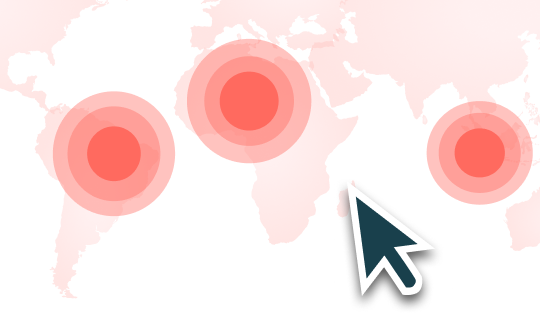Colombia is all but synonymous with coffee. The country is the world’s third largest coffee exporter (after Brazil and Vietnam) and Colombian coffee is prized for its well-balanced flavour. But climate change and global demand call the future sustainability of Colombian coffee production into question. Trase’s new Colombian coffee supply chain data could play a valuable role in managing those risks.
The new data show how Colombian coffee moves from the growing sites — at the level of Colombia’s 32 departments, roughly equivalent to a state or province — to international export markets. Like all Trase supply chain datasets, they additionally reveal the trading companies involved in export and import.
The dataset features a range of sustainability-related indicators and other useful information that can be overlaid onto a map of producer departments.
The big picture
Coffee production in Colombia is concentrated in a band of departments running from Cauca on the Pacific coast north up through Tolima, Caldas, Huila and Antioquia.
By far the biggest export market for Colombian coffee is the USA, importing 250,000–300,000 tons per year between 2012 and 2016, the period covered by the data. The next four biggest markets Japan, Germany, Canada and Belgium — in varying order — each importing 30,000–75,000 tons per year.
The biggest exporter is the Federacion Nacional de Cafeteros, a non-profit company that also provides agricultural extension services to coffee producers, along with a purchase guarantee at market prices.
Production is dominated by smallholders: around 95% of the more than half a million coffee producers in Colombia farm holdings of less than five hectares.
Forest at risk from coffee expansion due to climate change
The most interesting of the indicators in the new Colombian coffee data is “forest at risk of coffee expansion due to climate change by 2050”. Most of the current coffee-growing land in Colombia has been in use for decades. But a combination of factors, particularly climate change, could trigger a new wave of forest clearance.
Colombia produces arabica beans that favour higher elevations and specific levels of rainfall. Climate change is already changing rainfall patterns and affecting yields in coffee-growing areas, which could force farmers to shift production to higher altitudes, sometimes encroaching on sensitive montane ecosystems. As climate change intensifies and the global demand for coffee increases — it is set to triple by 2050 by some estimates — coffee production is likely to expand into new areas.
The new indicator is visible in a map overlay, showing the amount of upland forest in each department that will likely have the right conditions for coffee growing by 2050, based on a 2015 analysis.
“The indicator on future deforestation risk is very exciting, given the clear opportunity it presents us to take preventive action now,” says Trase Director Toby Gardner of Stockholm Environment Institute.
These potentially vulnerable areas stretch all along the Pacific coast, into the eastern regions and northwest into the biodiverse Chocó region. In Chocó department, where most of this region lies, 133,000 ha of forest are considered at risk. However, this is dwarfed by the amount of forest at risk in Antioquia (827,000 ha) and Cauca (618,3000 ha) departments, both of which are already major producers.
Water shortages already a risk in coffee producing regions
Another map overlay shows an index of vulnerability to water shortages for each department. Coffee is a rainfed crop, but post-harvest processing (e.g. washing the beans, fermentation) uses large volumes of water and loads the small streams at the headwaters of many rivers with organic waste, which potentially adds to environmental and social vulnerability. Coffee production can also cause erosion and run-off of pesticides and fertilizers.
The indicator shows that several of the departments where production is highest today — Huila, Tolima and Cauca — already have moderate levels of water vulnerability. Vulnerability is even higher in some of the other departments where there is an elevated risk of deforestation for coffee by 2050, such as Boyaca, Cesar and Magdalena.
Towards more sustainable sourcing?
In an effort to protect global coffee supplies in the face of climate breakdown, in 2015 Conservation International launched the Sustainable Coffee Challenge, a network that includes more than 100 companies across the coffee supply chain that are committed to making coffee the world’s first fully sustainable agricultural product. However, the lack of transparency in global supply chains has so far been a major obstacle.
“Often, there are so many links in the supply chain between farmers and consumers that it’s difficult to know where a product is coming from, and nearly impossible to understand what impacts it might be having on the ground,” says Margot Wood, a scientist and global sustainability fellow at Conservation International, which collaborated with Trase on developing the new data.
With the new Trase data, network members, traders, investors and importing countries can identify when coffee supply chains originate in areas exposed to sustainability risks. They can then choose to take steps to address the risks. For example, companies could work with local governments to make sure remaining forests are protected and that future coffee expansion instead happens on degraded land such as abandoned cattle pastures. Or they could support the expansion of certification schemes and other initiatives already active to help Colombia’s smallholder producers earn a decent living from sustainable coffee production.
“A company might be able to say, ‘I source from Colombia,’ but it’s not very meaningful,” says David Hole, Conservation International’s Vice President of Global Solutions. “With the new data, they can say, ‘I source from this region of Colombia, which we know has these climate change challenges, and we’ve improved water quality by working with producers.’”
Was this article useful?




